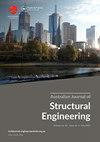集中荷载作用下RC梁弯矩重分布计算的新解析方法
IF 1.3
Q4 ENGINEERING, CIVIL
Australian Journal of Structural Engineering
Pub Date : 2021-04-03
DOI:10.1080/13287982.2021.1912518
引用次数: 1
摘要
通过线性弹性分析计算钢筋混凝土结构屈服后的弯矩,由于非线性行为,可能导致对其行为的不准确评估。因此,有必要使用更先进的方法来实现更高程度的结构性能优化,而不是由现有设计规范采用的基于内力重分布的线性弹性分析的简化方法所产生的结果。弯矩重分配应在混凝土出现裂缝后开始,但比例较小。在本研究中,将忽略屈服前的力矩再分配,而将重点放在屈服后的力矩再分配上。本文提出了一种分析钢筋混凝土梁屈服后弯矩重分布的数学模型。在该数学模型中,将塑性铰成形后的梁转化为可进行结构线性分析的虚拟梁。虚拟梁中的塑料铰链将表示为具有对诱导力矩的线性旋转刚度的旋转弹簧。通过在数学模型中推导出其与虚力矩之间的关系,可以得到实际力矩。对数学模型进行了验证,并给出了矩匹配的实验结果。同时,对所提出的数学模型与几种设计规范的弯矩重分配度进行了比较。分析结果表明,所建立的数学模型可用于分析钢筋混凝土梁的弯矩重分布。本文章由计算机程序翻译,如有差异,请以英文原文为准。
New analytical method for computing moment redistribution in RC beams under concentrated load
ABSTRACT Computing the moments in RC structures after the yield by linear elastic analysis can lead to an inaccurate assessment of the behaviour due to the nonlinear behaviour. Therefore, it can become necessary to use more advanced methodologies to achieve a higher degree of performance optimisation of structures than those resulting from the simplified approaches adopted by existing design codes based on linear elastic analysis with redistribution of internal forces. The moment redistribution is supposed to start after occurring the cracks of concrete, but with small ratio. In this study, the moment redistribution before the yielding will be neglected, and the redistribution is focused after the yield. This paper suggests a mathematical model to investigate the moment redistribution in RC beams after yielding analytically. In the suggested mathematical model, the beam after forming the plastic hinges is converted into a virtual beam that can be analysed by structural linear analysis. The plastic hinges in the virtual beam will be represented as rotational springs having a linear rotational stiffness against the induced moment. The actual moments can be found through derived relationships in the mathematical model between it and the virtual moment. The mathematical model was verified and it gave values of moment matching experimental results. Also, a comparison for degree of moment redistribution among the suggested mathematical model and several design codes was performed. The analytical results indicate that the proposed mathematical model can be used for analysis of moment redistribution of RC beams.
求助全文
通过发布文献求助,成功后即可免费获取论文全文。
去求助
来源期刊

Australian Journal of Structural Engineering
ENGINEERING, CIVIL-
CiteScore
2.50
自引率
0.00%
发文量
31
期刊介绍:
The Australian Journal of Structural Engineering (AJSE) is published under the auspices of the Structural College Board of Engineers Australia. It fulfils part of the Board''s mission for Continuing Professional Development. The journal also offers a means for exchange and interaction of scientific and professional issues and technical developments. The journal is open to members and non-members of Engineers Australia. Original papers on research and development (Technical Papers) and professional matters and achievements (Professional Papers) in all areas relevant to the science, art and practice of structural engineering are considered for possible publication. All papers and technical notes are peer-reviewed. The fundamental criterion for acceptance for publication is the intellectual and professional value of the contribution. Occasionally, papers previously published in essentially the same form elsewhere may be considered for publication. In this case acknowledgement to prior publication must be included in a footnote on page one of the manuscript. These papers are peer-reviewed as new submissions. The length of acceptable contributions typically should not exceed 4,000 to 5,000 word equivalents. Longer manuscripts may be considered at the discretion of the Editor. Technical Notes typically should not exceed about 1,000 word equivalents. Discussions on a Paper or Note published in the AJSE are welcomed. Discussions must address significant matters related to the content of a Paper or Technical Note and may include supplementary and critical comments and questions regarding content.
 求助内容:
求助内容: 应助结果提醒方式:
应助结果提醒方式:


